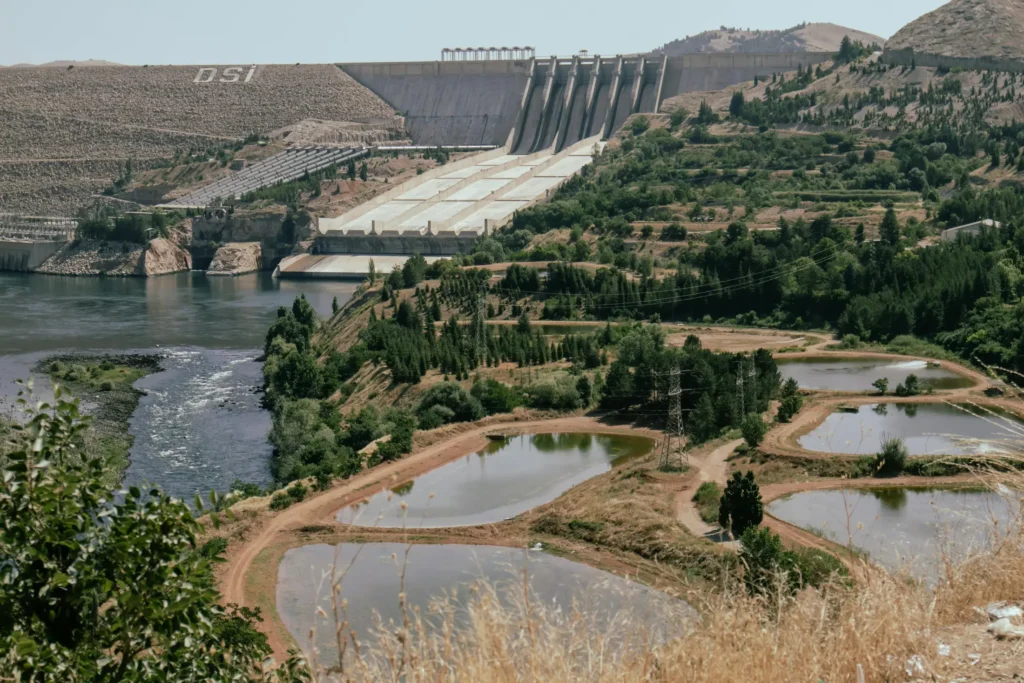Hydropower generates electricity by converting the energy of flowing water. The water is trapped in a reservoir, carried through penstocks (large pipes), which rotate the turbine and propel the generator. The generated electricity is fed into domestic and commercial grids.

Step-by-Step Process of Hydropower Generation
1. Water Collection (Reservoir Filling)
Rivers are dammed to form reservoirs. Reservoirs are filled with snowmelt and rain, storing potential energy by elevation—known as “head.” The more water stored and the more elevation, the more potential energy.
2. Water Flow Through Penstocks
Where there is a desire for power, water from the reservoir is released and falls through penstocks—steel or concrete pipes—for a tremendous vertical drop. This high-speed water holds kinetic energy.
3. Turbine Rotation
Water hits the turbine blades at the turbine’s penstock end, causing them to spin. Mechanical energy is generated from the moving water in the turbine.
4. Generating Electricity
It is paired with a generator. Upon rotation, it rotates a shaft that is fitted with magnets inside a coil of wire. Electricity is created when this movement uses electromagnetic induction to create an electrical current.
5. Water Returns to River
After it goes through the turbine, the water flows back to the river downstream—capable of entering the natural water cycle once again. That is why hydropower is a renewable energy.
Types of Hydropower Plants
Hydropower exists in three broad forms, depending on the way water is harnessed and managed:
1. Run-of-River Systems
Water is diverted off a river by a small weir and fed into a turbine. It does not require large reservoirs.
2. Reservoir (Storage) Systems
Keep water behind massive dams and generate electricity as required—most widely practiced method.
3. Pumped-Storage Systems
During low-demand days, excess electricity pushes water into an upper reservoir. During high-demand days, that water is released to power turbines—essentially a battery.
Basic Principle of Hydropower
Hydropower relies on the transformation of potential energy (stored water at an elevation) to kinetic energy (flowing water) followed by transformation to mechanical energy (via turbine) and, finally, electrical energy (via generator).
FAQs
Q1: What is the basic principle of hydropower?
Hydropower generates electricity through electromagnetic induction and uses the potential energy of falling water (caused by gravity) to power turbines.
Q2: Does hydropower use the water cycle?
Due to its reliance on precipitation and snowmelt, hydropower is a renewable energy source since the continuous water cycle replenishes reservoirs.
Q3: Are there environmental downsides?
Dam construction can influence river biology and fish passage. But many systems now have fish ladders and environmental flows to minimize that.
Q4: How efficient is hydropower?
Hydropower is highly efficient—typically greater than 90%. It’s also scalable and predictable, from small community systems to massive dams.
References
The information in this article is based on insights from respected organizations in the energy field. We have reviewed content from the following sources to ensure accuracy and relevance:
- U.S. Department of Energy
- National Renewable Energy Laboratory
- Britannica
- U.S. Energy Information Administration
- USGS
Posted by Abu Talha
With a background in science at the A-level, Abu Talha has studied subjects including physics, chemistry, mathematics, and biology. Along with his more than 1.5 years of experience in digital marketing, he is passionate about writing about electric vehicles, sustainable energy, and how emerging technologies are influencing the future.

